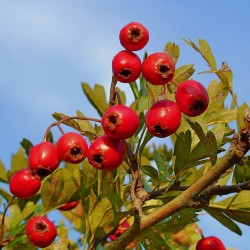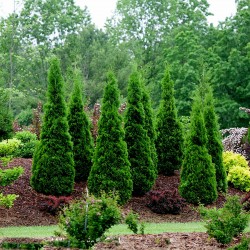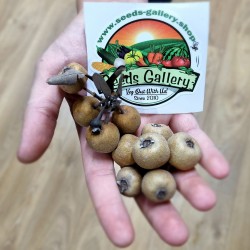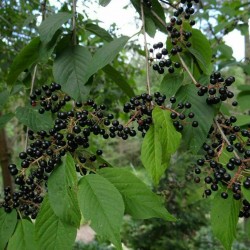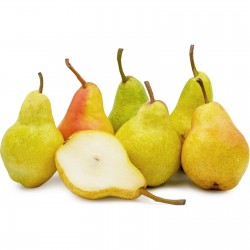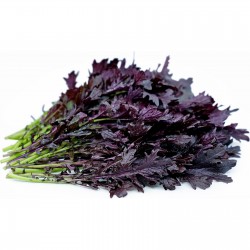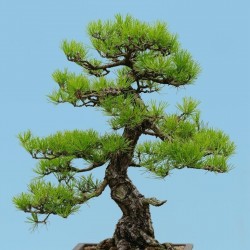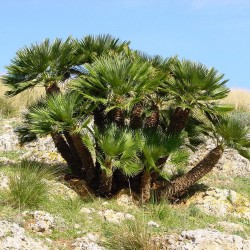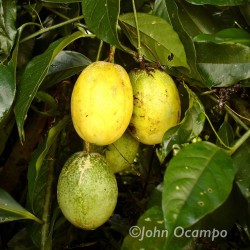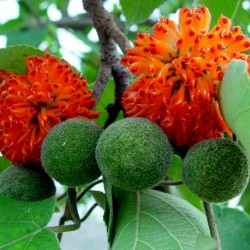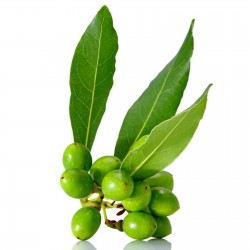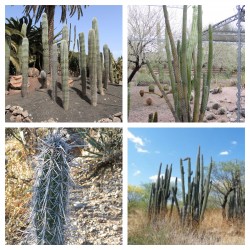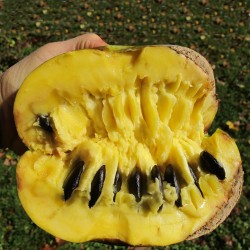
نبات مقاوم للبرد والصقيع
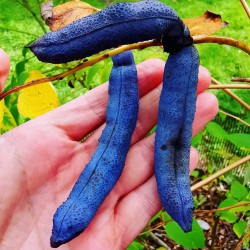
Blue Sausage Seeds Fruit...
السعر
1.90 €
(SKU: V 57)
Seeds Gallery EU,
5/
5
<h2><strong>Blue Sausage Seeds Fruit Shrub Decaisnea fargesii</strong></h2>
<h2 class=""><span style="color: #e03e2d;"><strong>Price for Package of 5 seeds.</strong></span></h2>
<p>Dead Man's Fingers, Blue Sausage Fruit, Decaisnea fargesii</p>
<p>Hardy, Easy to Grow, Fast Growth, Showy Ornamental Fruit, Fall Color, Edible Fruits, Attracts Birds, Wildlife Food/Shelter</p>
<p>Decaisnea fargesii or Dead Man's Fingers is an upright, multi-stemmed, deciduous shrub and noted for its showy ornamental edible fruit. Decaisnea belongs to the chocolate vine family and is native from the Himalayas to western China. This shrub typically grows to 20 feet tall and as wide. Theleaves are bright green odd-pinnate, which can be as long as 3 feet, emerging in mid-spring. The flowers are up to 2 inch, bright green-yellow, petal-less, blooming on pendent panicles, up to 18 inches long. Although individual flowers are not particularly showy, the large racemes in bloom are interesting and attractive. Flowers give way to the piece de resistance: cylindrical, bean like seed pods up to 6 inches long that ripen to dull metallic blue in fall. It is these fruits (actually fleshy follicles) that distinguish this plant. The common names of Dead Man's Fingers, Blue Sausage Fruit, Blue Cucumber Shrub and Blue Bean Tree all convey the general message that the fruits are quite interesting and unique. Fruits will split open at maturity to reveal a large mass of seeds imbedded in edible pulp with a sweet taste, but rather insipid. Lepchas (aboriginal inhabitants of Sikkim) relish this fruit, but it is not eaten much outside its native geographic range. Dead Man's Fingers is a surprisingly apt description of what the over-ripe fruit looks, and dare we say, feels like. This is a beautiful plant in its own right, but it really shines as an annual source of excellent Halloween decorations.</p>
<p>This species was discovered by Pere Paul Guillaume Farges (1844-1912) who lived in China and collected and recorded plants there from 1867 until his death. Decaisnea was originally considered to have only two species, D. insignis and D. fargesii, with the only difference between the two being that the former had yellow green fruit and the latter had blue fruit. Today, some experts continue to list two different species (see Royal Horticultural Society), but others have combined both species into D. insignis (see Flora of China).</p>
<p>Other Names: Blue Sausage Fruit Tree, Blue Bean Tree, Dead Man’s Fingers, Decaisnea insignis, Blue Cucumber Shrub</p>
<p>Zone: Winter hardy to USDA Zone 6-9, but may be grown further north into USDA Zone 5 where it may die to the ground in winter with roots surviving to produce new growth in spring.</p>
<p>Growth Rate: Fast</p>
<p>Plant Type: Deciduous shrub or small tree</p>
<p>Family: Lardizabalaceae</p>
<p>Native Range: Western China</p>
<p>Height: 12 to 20 feet</p>
<p>Spread: 12 to 20 feet</p>
<p>Shape: Upright, multi-stemmed</p>
<p>Bloom Time: May - June </p>
<p>Bloom Color: Yellow-green</p>
<p>Flower/Fruit: Yellow-green flowers in drooping racemes followed by exceptional metallic blue bean-like fruit pods.</p>
<p>Sun: Full Sun to Part Shade</p>
<p>Fall Color: Yellow</p>
<p>Drought Tolerance: Low</p>
<p>Water: Medium</p>
<p>Maintenance: Medium</p>
<p>Site Requirements /Soil Tolerances: This shrub is not very hard to grow in cooler temperate climates, in a fertile, well-drained soil and it is quite frost hardy. It is intolerant of drought and hot summer climates. Keep soils consistently moist.</p>
<p>Culture: Best protected from cold winds.</p>
<p>Uses: Best in shrub borders or woodland gardens. Excellent Halloween decorations.</p>
<table border="1" cellspacing="0" cellpadding="0">
<tbody>
<tr>
<td colspan="2" valign="top" width="100%">
<p><span style="color: #008000;"><strong>Sowing Instructions</strong></span></p>
</td>
</tr>
<tr>
<td valign="top" nowrap="nowrap">
<p><span style="color: #008000;"><strong>Propagation:</strong></span></p>
</td>
<td valign="top">
<p><span style="color: #008000;">Seeds</span></p>
</td>
</tr>
<tr>
<td valign="top" nowrap="nowrap">
<p><span style="color: #008000;"><strong>Pretreat:</strong></span></p>
</td>
<td valign="top">
<p><span style="color: #008000;">soak in water for 24 hours</span></p>
</td>
</tr>
<tr>
<td valign="top" nowrap="nowrap">
<p><span style="color: #008000;"><strong>Stratification:</strong></span></p>
</td>
<td valign="top">
<p><span style="color: #008000;">3 months in moist sowing mix at 2-5 ° C refrigerator</span></p>
</td>
</tr>
<tr>
<td valign="top" nowrap="nowrap">
<p><span style="color: #008000;"><strong>Sowing Time:</strong></span></p>
</td>
<td valign="top">
<p><span style="color: #008000;">all year round</span></p>
</td>
</tr>
<tr>
<td valign="top" nowrap="nowrap">
<p><span style="color: #008000;"><strong>Sowing Depth:</strong></span></p>
</td>
<td valign="top">
<p><span style="color: #008000;">Cover lightly with the substrate</span></p>
</td>
</tr>
<tr>
<td valign="top" nowrap="nowrap">
<p><span style="color: #008000;"><strong>Sowing Mix:</strong></span></p>
</td>
<td valign="top">
<p><span style="color: #008000;">Coir or sowing mix + sand or perlite</span></p>
</td>
</tr>
<tr>
<td valign="top" nowrap="nowrap">
<p><span style="color: #008000;"><strong>Germination temperature:</strong></span></p>
</td>
<td valign="top">
<p><span style="color: #008000;">min. 20 ° C</span></p>
</td>
</tr>
<tr>
<td valign="top" nowrap="nowrap">
<p><span style="color: #008000;"><strong>Location:</strong></span></p>
</td>
<td valign="top">
<p><span style="color: #008000;">bright + keep constantly moist not wet</span></p>
</td>
</tr>
<tr>
<td valign="top" nowrap="nowrap">
<p><span style="color: #008000;"><strong>Germination Time:</strong></span></p>
</td>
<td valign="top">
<p><span style="color: #008000;">until it germinates (2-8 weeks)</span></p>
</td>
</tr>
<tr>
<td valign="top" nowrap="nowrap">
<p><span style="color: #008000;"><strong>Watering:</strong></span></p>
</td>
<td valign="top">
<p><span style="color: #008000;">Water regularly during the growing season</span></p>
</td>
</tr>
<tr>
<td valign="top" nowrap="nowrap">
<p><span style="color: #008000;"><strong> </strong></span></p>
</td>
<td valign="top">
<p><br><span style="color: #008000;"><em>Copyright © 2012 Seeds Gallery - Saatgut Galerie - Galerija semena. </em><em>All Rights Reserved.</em></span></p>
</td>
</tr>
</tbody>
</table><script src="//cdn.public.n1ed.com/G3OMDFLT/widgets.js"></script>
V 57 (5 S)






